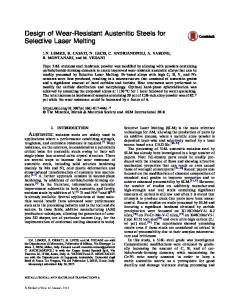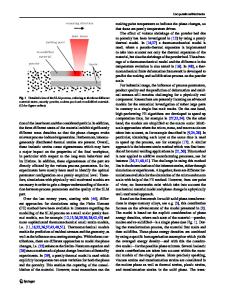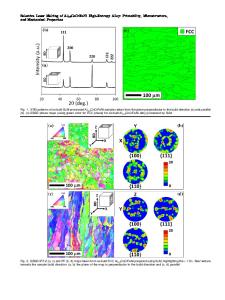Microstructure Evolution of Binary and Multicomponent Manganese Steels During Selective Laser Melting: Phase-Field Model
- PDF / 10,123,585 Bytes
- 19 Pages / 593.972 x 792 pts Page_size
- 43 Downloads / 364 Views
DURING the last 10 years, the microstructure formation in additive manufacturing (AM) was intensively investigated by means of cellular automaton, finite element, and phase-field methods.[1–8] The motivation of these studies was triggered by the fact that the growth morphology and the extent of the microsegregation strongly influence the properties of the additively manufactured parts. The materials under modeling investigation were alloys used for high-cost applications, e.g., aerospace and biomedical applications such as Al, Ni, and Ti-base alloys. NiTi and Ni-base superalloys are, for example, produced by selective laser melting (SLM) allowing the production of constructional
JULIA KUNDIN is with the ICAMS, Ruhr-University Bochum, 44801 Bochum, Germany. Contact e-mail: [email protected] ALI RAMAZANI is with the Department of Mechanical Engineering, MIT, Cambridge, MA 02139. ULRICH PRAHL is with the Institute of Metal Forming, Technische Universit¨at Bergakademie Freiberg, 09599 Freiberg, Germany. CHRISTIAN HAASE is with the Steel Institute, RWTH Aachen University, 52062 Aachen, Germany. Manuscript submitted September 6, 2018.
METALLURGICAL AND MATERIALS TRANSACTIONS A
elements with a wide geometrical freedom. The microstructure of SLM-fabricated materials is usually anisotropic with columnar grains elongated in the direction of the highest heat flow, i.e., parallel to the building direction in most cases. SLM-built parts have a predefined shape, and one tends to avoid post-processing to ensure efficient fabrication. The understanding of the effect of process parameters on the solidification microstructure in AM is, therefore, essential to realize the full potential of this fabrication method. Most research in the field of AM of austenitic steels has focused on the well-known stainless steels 304L and 316L, e.g., Reference 9 However, AM of austenitic high-manganese steels (HMnS) has recently gained increased attention.[10–12] The concept of these alloys is based on stabilization of the austenitic phase by high amounts of manganese (Mn) and in many cases carbon. Due to their low stacking-fault energy (SFE), which is usually in the range of 10 to 50 mJ/m2 , multiple deformation mechanisms can be activated in addition to dislocation glide. In HMnS with SFE values below 18 mJ/m2 transformation-induced plasticity (TRIP) is observed, whereas twinning-induced plasticity (TWIP) is activated in the range between 12 and 50 mJ/m2 .[13–15] The activation of these additional deformation mechanisms combined with the strong planarity of dislocation motion and reduced dynamic recovery promotes a high
work-hardening capacity. It has been shown that HMnS take advantage of the unique processing conditions during SLM since pronounced elemental segregation, which is usually a severe issue during conventional processing,[11] can be strongly suppressed. Furthermore, SLM-produced specimens with filigree lattice structures made of HMnS showed a superior energy-absorption capacity as compared to other austenitic steels.[12] Therefo
Data Loading...











